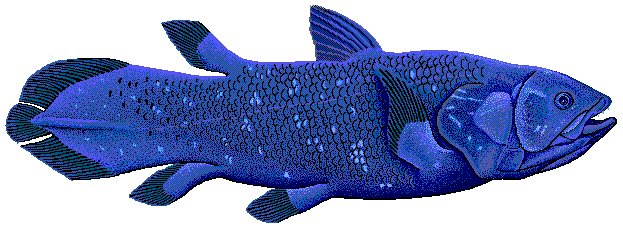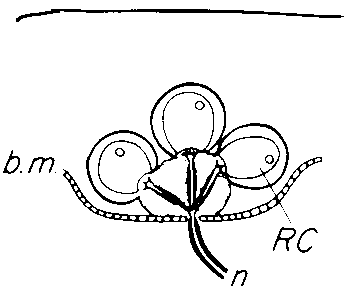|
Electroreceptor
Electroreception and electrogenesis are the closely related biological abilities to perceive electrical stimuli and to generate electric fields. Both are used to locate prey; stronger electric discharges are used in a few groups of fishes, such as the electric eel, to stun prey. The capabilities are found almost exclusively in aquatic or amphibious animals, since water is a much better conductor of electricity than air. In passive electrolocation, objects such as prey are detected by sensing the electric fields they create. In active electrolocation, fish generate a weak electric field and sense the different distortions of that field created by objects that conduct or resist electricity. Active electrolocation is practised by two groups of weakly electric fish, the order Gymnotiformes (knifefishes) and family Mormyridae (elephantfishes), and by the monotypic genus '' Gymnarchus'' (African knifefish). An electric fish generates an electric field using an electric organ, modi ... [...More Info...] [...Related Items...] OR: [Wikipedia] [Google] [Baidu] |
Ampullae Of Lorenzini
Ampullae of Lorenzini (: ''ampulla'') are electroreceptors, sense organs able to detect electric fields. They form a network of mucus-filled pores in the skin of Chondrichthyes, cartilaginous fish (sharks, Ray (fish), rays, and chimaeras) and of basal Osteichthyes, bony fishes such as reedfish, sturgeon, and lungfish. They are associated with and evolved from the mechanosensory lateral line organs of early vertebrates. Most bony fishes and terrestrial vertebrates have lost their ampullae of Lorenzini. History Ampullae were initially described by Marcello Malpighi and later given an exact description by the Italian physician and ichthyologist Stefano Lorenzini in 1679, though their function was unknown. Electrophysiology, Electrophysiological experiments in the 20th century suggested a sensibility to temperature, mechanical pressure, and possibly salinity. In 1960 the ampullae were identified as specialized receptor organs for sensing electric fields. One of the first descriptio ... [...More Info...] [...Related Items...] OR: [Wikipedia] [Google] [Baidu] |
Platypus
The platypus (''Ornithorhynchus anatinus''), sometimes referred to as the duck-billed platypus, is a semiaquatic, egg-laying mammal endemic to eastern Australia, including Tasmania. The platypus is the sole living representative or monotypic taxon of its family Ornithorhynchidae and genus ''Ornithorhynchus'', though a number of related species appear in the fossil record. Together with the four species of echidna, it is one of the five extant species of monotremes, mammals that lay eggs instead of giving birth to live young. Like other monotremes, the platypus has a sense of electrolocation, which it uses to detect prey in cloudy water. It is one of the few species of venomous mammals, as the male platypus has a spur on the hind foot that delivers an extremely painful venom. The unusual appearance of this egg-laying, duck-billed, beaver-tailed, otter-footed mammal at first baffled European naturalists. In 1799, the first scientists to examine a preserved platypus bod ... [...More Info...] [...Related Items...] OR: [Wikipedia] [Google] [Baidu] |
Electric Fish
An electric fish is any fish that can Bioelectrogenesis, generate electric fields, whether to sense things around them, for defence, or to stun prey. Most fish able to produce shocks are also electroreceptive, meaning that they can sense electric fields. The only exception is the Uranoscopidae, stargazer family (Uranoscopidae). Electric fish, although a small minority of all fishes, include both oceanic and freshwater species, and both cartilaginous and bony fishes. Electric fish produce their electrical fields from an Electric organ (biology), electric organ. This is made up of electrocytes, modified muscle or nerve cells, specialized for producing strong electric fields, used to locate prey, for Anti-predator adaptation, defence against predators, and for Signalling theory, signalling, such as in courtship. Electric organ discharges are two types, pulse and wave, and vary both by species and by function. Electric fish have evolved many specialised behaviours. The predatory Cla ... [...More Info...] [...Related Items...] OR: [Wikipedia] [Google] [Baidu] |
Mormyridae
The Mormyridae, sometimes called "elephantfish" (more properly freshwater elephantfish), are a superfamily of weakly electric fish in the order Osteoglossiformes native to Africa. It is by far the largest family in the order, with around 200 species. Members of the family can be popular, if challenging, aquarium species. These fish have a large brain size and unusually high intelligence. They are not to be confused with the marine and brackish-water callorhinchid elephantfish (family Callorhinchidae) of Southern Hemisphere oceans. Description and biology The elephantfish are a diverse family, with a wide range of different sizes and shapes. The smallest are just in adult length, while the largest reach up to . They do, however, have a number of unique features in common. Firstly, their cerebellum is greatly enlarged, enabling them to interpret complex bio-electrical signals, and to the large size of the valve. Secondly, an auditory vesicle (a small bladder) is present insid ... [...More Info...] [...Related Items...] OR: [Wikipedia] [Google] [Baidu] |
Electric Eel
The electric eels are a genus, ''Electrophorus'', of neotropical freshwater fish from South America in the family Gymnotidae, of which they are the only members of the subfamily Electrophorinae. They are known for their electric fish, ability to stun their prey by generating electricity, delivering shocks at up to 860 volts. Their electrical capabilities were first studied in 1775, contributing to the invention of the electric battery in 1800. Despite their name, electric eels are not closely related to the true eels (Anguilliformes) but are members of the electroreceptive knifefish Order (biology), order Gymnotiformes. This order is more closely related to catfish. In 2019, electric eels were split into three species: for more than two centuries before that, the genus was believed to be monotypic, containing only ''Electrophorus electricus.'' They are nocturnal, obligate air-breathing animals, with poor vision complemented by Electroreception and electrogenesis#Electrolocati ... [...More Info...] [...Related Items...] OR: [Wikipedia] [Google] [Baidu] |
Sturgeon
Sturgeon (from Old English ultimately from Proto-Indo-European language, Proto-Indo-European *''str̥(Hx)yón''-) is the common name for the 27 species of fish belonging to the family Acipenseridae. The earliest sturgeon fossils date to the Late Cretaceous, and are descended from other, earlier Acipenseriformes, acipenseriform fish, which date back to the Early Jurassic period, some 174 to 201 million years ago. They are one of two living families of the Acipenseriformes alongside paddlefish (Polyodontidae). The family is grouped into five genera: ''Acipenser'', ''Huso'', ''Scaphirhynchus,'' ''Sinosturio'', and ''Pseudoscaphirhynchus''. Two species (''Adriatic sturgeon, H. naccarii'' and ''Dabry's sturgeon, S. dabryanus'') may be extinct in the wild, and one (''Syr Darya sturgeon, P. fedtschenkoi'') may be entirely extinct. Sturgeons are native to subtropical, temperate and sub-Arctic rivers, lakes and coastlines of Eurasia and North America. A Maastrichtian-age fossil found i ... [...More Info...] [...Related Items...] OR: [Wikipedia] [Google] [Baidu] |
Knollenorgan
A Knollenorgan is an electroreceptor in the skin of weakly electric fish of the family Mormyridae (Elephantfish) from Africa. The structure was first described by Viktor Franz (1921), a German anatomist unaware of its function. They are named after "Knolle", German for "tuberous root" which describes their structure. Structure and function Knollenorgans contain modified Epithelium, epithelial cells that act as Transduction (physiology), sensory transducers for electric fields. Besides these, there are supporting cells and a sensory neuron. The neuron projects to the fish's brain, specifically to the nucleus of the electrosensory lateral line lobe (nELL) of the medulla oblongata, medulla via the posterior branch of the lateral line nerve. The organs are embedded in the thickened Epidermis (skin), epidermis. The receptor cells lie buried in the deeper layers of the epidermis, where they expand into a pocket in the superficial layers of the Dermis, corium. The sense organ is surro ... [...More Info...] [...Related Items...] OR: [Wikipedia] [Google] [Baidu] |
Chondrichthyes
Chondrichthyes (; ) is a class of jawed fish that contains the cartilaginous fish or chondrichthyans, which all have skeletons primarily composed of cartilage. They can be contrasted with the Osteichthyes or ''bony fish'', which have skeletons primarily composed of bone tissue. Chondrichthyes are aquatic vertebrates with paired fins, paired nares, placoid scales, conus arteriosus in the heart, and a lack of opercula and swim bladders. Within the infraphylum Gnathostomata, cartilaginous fishes are distinct from all other jawed vertebrates. The class is divided into two subclasses: Elasmobranchii (sharks, rays, skates and sawfish) and Holocephali ( chimaeras, sometimes called ghost sharks, which are sometimes separated into their own class). Extant chondrichthyans range in size from the finless sleeper ray to the over whale shark. Anatomy Skeleton The skeleton is cartilaginous. The notochord is gradually replaced by a vertebral column during development, e ... [...More Info...] [...Related Items...] OR: [Wikipedia] [Google] [Baidu] |
Gymnotiformes
The Gymnotiformes are an order of teleost bony fishes commonly known as Neotropical knifefish or South American knifefish. They have long bodies and swim using undulations of their elongated anal fin. Found almost exclusively in fresh water (the only exceptions are species that occasionally may visit brackish water to feed), these mostly nocturnal fish are capable of producing electric fields to detect prey, for navigation, communication, and, in the case of the electric eel (''Electrophorus electricus''), attack and defense. A few species are familiar to the aquarium trade, such as the black ghost knifefish (''Apteronotus albifrons''), the glass knifefish (''Eigenmannia virescens''), and the banded knifefish (''Gymnotus carapo''). Description Anatomy and locomotion Aside from the electric eel (''Electrophorus electricus''), Gymnotiformes are slender fish with narrow bodies and tapering tails, hence the common name of "knifefishes". They have neither pelvic fins nor d ... [...More Info...] [...Related Items...] OR: [Wikipedia] [Google] [Baidu] |
Echidna
Echidnas (), sometimes known as spiny anteaters, are quill-covered monotremes (egg-laying mammals) belonging to the Family (biology), family Tachyglossidae , living in Australia and New Guinea. The four Extant taxon, extant species of echidnas and the platypus are the only living mammals that lay eggs and the only surviving members of the order (biology), order Monotremata. The diet of some species consists of ants and termites, but they are not closely related to the American anteater, true anteaters or to Hedgehog, hedgehogs. Their young are called puggles. Echidnas evolved between 20 and 50 million years ago, descending from a platypus-like monotreme. This ancestor was aquatic, but echidnas adapted to life on land, where a single individual can move seven tons of soil each year, making them important for the environment. Etymology Echidnas are possibly named after Echidna (mythology), Echidna, a creature from Greek mythology who was half-woman, half-snake, as the anima ... [...More Info...] [...Related Items...] OR: [Wikipedia] [Google] [Baidu] |
Shark
Sharks are a group of elasmobranch cartilaginous fish characterized by a ribless endoskeleton, dermal denticles, five to seven gill slits on each side, and pectoral fins that are not fused to the head. Modern sharks are classified within the Division (taxonomy), division Selachii and are the sister group to the Batoidea, Batomorphi (Batoidea, rays and skate (fish), skates). Some sources extend the term "shark" as an informal category including Extinction, extinct members of Chondrichthyes (cartilaginous fish) with a shark-like morphology, such as hybodonts. Shark-like chondrichthyans such as ''Cladoselache'' and ''Doliodus'' first appeared in the Devonian Period (419–359 million years), though some fossilized chondrichthyan-like scales are as old as the Ordovician, Late Ordovician (458–444 million years ago). The earliest confirmed modern sharks (Selachii) are known from the Early Jurassic around , with the oldest known member being ''Agaleus'', though records of true shar ... [...More Info...] [...Related Items...] OR: [Wikipedia] [Google] [Baidu] |






